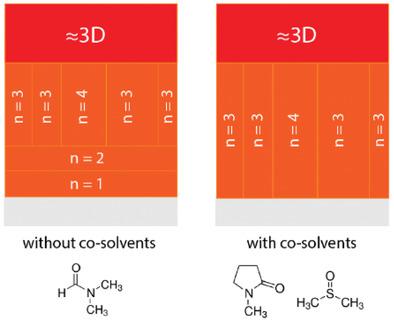当前位置:
X-MOL 学术
›
Adv. Energy Mater.
›
论文详情
Our official English website, www.x-mol.net, welcomes your feedback! (Note: you will need to create a separate account there.)
Effect of Co-Solvents on the Crystallization and Phase Distribution of Mixed-Dimensional Perovskites
Advanced Energy Materials ( IF 27.8 ) Pub Date : 2021-10-05 , DOI: 10.1002/aenm.202102144 Alessandro Caiazzo 1 , Kunal Datta 1 , Junke Jiang 2, 3 , María C. Gélvez‐Rueda 4 , Junyu Li 1 , Riccardo Ollearo 1 , José Manuel Vicent‐Luna 2, 3 , Shuxia Tao 2, 3 , Ferdinand C. Grozema 4 , Martijn M. Wienk 1 , René A. J. Janssen 1, 5
Advanced Energy Materials ( IF 27.8 ) Pub Date : 2021-10-05 , DOI: 10.1002/aenm.202102144 Alessandro Caiazzo 1 , Kunal Datta 1 , Junke Jiang 2, 3 , María C. Gélvez‐Rueda 4 , Junyu Li 1 , Riccardo Ollearo 1 , José Manuel Vicent‐Luna 2, 3 , Shuxia Tao 2, 3 , Ferdinand C. Grozema 4 , Martijn M. Wienk 1 , René A. J. Janssen 1, 5
Affiliation

|
Solution-processed quasi-2D perovskites are promising for stable and efficient solar cells because of their superior environmental stability compared to 3D perovskites and tunable optoelectronic properties. Changing the number of inorganic layers (n) sandwiched between the organic spacers allows for tuning of the bandgap. However, narrowing the phase distribution around a specific n-value is a challenge. In-situ UV–vis–NIR absorption spectroscopy is used to time-resolve the crystallization dynamics of quasi-2D butylammonium-based (BA) perovskites with <n> = 4, processed from N,N-dimethylformamide (DMF) in the presence of different co-solvents. By combining with photoluminescence, transient absorption, and grazing-incidence wide-angle X-ray scattering, the crystallization is correlated to the distribution of phases with different n-values. Infrared spectroscopy and density functional theory reveal that the phase distribution correlates with perovskite precursor—co-solvent interaction energies and that stronger interactions shift the phase distribution towards smaller n-values. Careful tuning of the solvent/co-solvent ratio provides a more homogeneous phase distribution, with highly oriented perovskite crystals and suppressed formation of n = 1–2 phases, providing a power conversion efficiency for BA2MA3Pb4I13 solar cells that increases from 3.5% when processed from DMF to over 11% and 10% when processed from DMF/dimethyl sulfoxide and DMF/N-methyl-2-pyrrolidone mixtures, respectively.
中文翻译:

共溶剂对混合维钙钛矿结晶和相分布的影响
溶液处理的准 2D 钙钛矿有望用于稳定高效的太阳能电池,因为与 3D 钙钛矿相比,它们具有优异的环境稳定性和可调谐的光电特性。改变夹在有机间隔物之间的无机层 ( n )的数量允许调整带隙。然而,缩小特定n值周围的相位分布是一个挑战。原位 UV-vis-NIR 吸收光谱用于时间分辨准二维丁铵基 (BA) 钙钛矿的结晶动力学,其中 < n > = 4,由N,N加工而成-二甲基甲酰胺 (DMF) 在不同的共溶剂存在下。通过结合光致发光、瞬态吸收和掠入射广角 X 射线散射,结晶与具有不同n 值的相的分布相关。红外光谱和密度泛函理论表明,相分布与钙钛矿前体——共溶剂相互作用能相关,并且更强的相互作用使相分布向更小的n值移动。仔细调整溶剂/共溶剂比可提供更均匀的相分布,具有高度取向的钙钛矿晶体并抑制n = 1-2 相的形成,为 BA 2 MA提供功率转换效率3 Pb 4 I 13太阳能电池从DMF处理时的3.5%增加到DMF/二甲亚砜和DMF/ N-甲基-2-吡咯烷酮混合物处理时的11%和10%以上。
更新日期:2021-11-11
中文翻译:

共溶剂对混合维钙钛矿结晶和相分布的影响
溶液处理的准 2D 钙钛矿有望用于稳定高效的太阳能电池,因为与 3D 钙钛矿相比,它们具有优异的环境稳定性和可调谐的光电特性。改变夹在有机间隔物之间的无机层 ( n )的数量允许调整带隙。然而,缩小特定n值周围的相位分布是一个挑战。原位 UV-vis-NIR 吸收光谱用于时间分辨准二维丁铵基 (BA) 钙钛矿的结晶动力学,其中 < n > = 4,由N,N加工而成-二甲基甲酰胺 (DMF) 在不同的共溶剂存在下。通过结合光致发光、瞬态吸收和掠入射广角 X 射线散射,结晶与具有不同n 值的相的分布相关。红外光谱和密度泛函理论表明,相分布与钙钛矿前体——共溶剂相互作用能相关,并且更强的相互作用使相分布向更小的n值移动。仔细调整溶剂/共溶剂比可提供更均匀的相分布,具有高度取向的钙钛矿晶体并抑制n = 1-2 相的形成,为 BA 2 MA提供功率转换效率3 Pb 4 I 13太阳能电池从DMF处理时的3.5%增加到DMF/二甲亚砜和DMF/ N-甲基-2-吡咯烷酮混合物处理时的11%和10%以上。



























 京公网安备 11010802027423号
京公网安备 11010802027423号